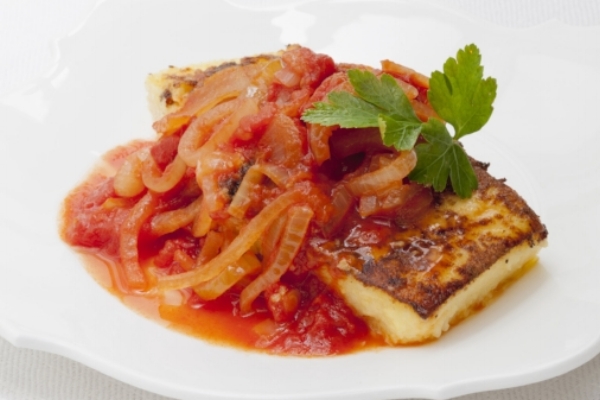Until I began growing eggplant, I had no idea how vibrant, smoky, and intense it could be, so fresh and firm, picked just seconds before preparation. Come August, my garden flourishes with those shiny black, lean and long vegetables, hanging from their neat little tree-like plants, ready for the oven, the skillet, the grill. I like to harvest them small, when I feel the flavor is more intense. This roasted eggplant buried in a spicy tomato sauce is a personal favorite, with multiple variations. I like to serve it as a vegetarian main dish, sometimes showered with cubes of feta cheese and warmed just until the cheese begins to melt. The dish could also serve as a pasta sauce: chop the eggplant as it comes from the oven, then drop the cubes into the tomato sauce. Cumin, ginger, and pepper flakes have their place here as model partners to the versatile eggplant.
8 servings
Equipment
A baking sheet; a large, deep skillet with a lid.
INGREDIENTS
4 small, firm, fresh eggplants (each about 8 ounces; 250 g), washed but not peeled
2 tablespoons extra-virgin olive oil
1 teaspoon fine sea salt
2 onions, peeled, halved, and thinly sliced
6 plump, fresh garlic cloves, peeled, halved, and green germ removed
2 tablespoons finely slivered fresh ginger
1/4 teaspoon red pepper flakes, or to taste
2 teaspoons ground cumin, toasted
One 28-ounce (794 g) can diced Italian tomatoes in juice
1 cup (125 g) Greek feta cheese, cubed (optional)
METHOD
1. Center a rack in the oven. Preheat the oven to 425°F (220°C).
2. Trim and discard the stem ends of the eggplants. Halve them lengthwise. Brush the flesh lightly with some of the oil and season lightly with salt. Place the eggplant halves, cut side down, on a baking sheet. Place in the oven and bake until the eggplant skin is soft and wrinkled and the cut side is golden, about 30 minutes.
3. When the eggplants have almost finished cooking, prepare the sauce: In the skillet, combine the onions, garlic, the remaining oil, and salt to taste. Toss to thoroughly coat the onions and garlic with the oil, and sweat – cook, covered, over low heat until soft and translucent – about 5 minutes. Add the ginger, pepper flakes, and cumin, and toss to evenly coat the onions. Add the tomatoes with juices and simmer, covered, for about 5 minutes.
4. Add the roasted eggplant halves, burying them, cut side down, in the sauce. Cover and cook until the eggplant is very tender and has absorbed much of the sauce, about 20 minutes. If using, add the cubes of feta cheese, warming the dish until the cheese melts. Taste for seasoning. Serve.
This recipe was first published in The French Kitchen Cookbook.
All rights reserved. Please do not reproduce without permission.
















